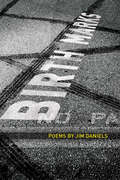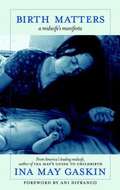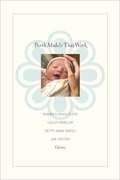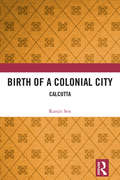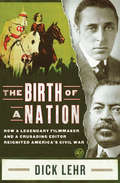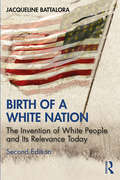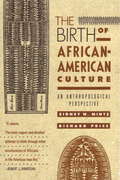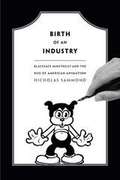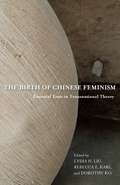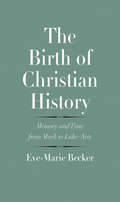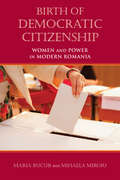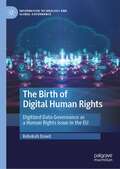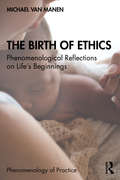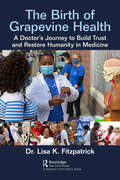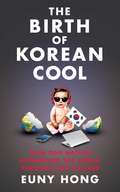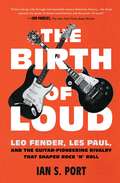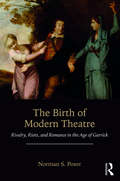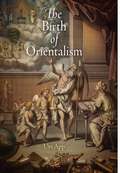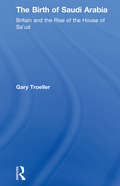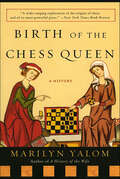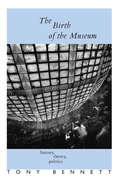- Table View
- List View
Birth Marks (American Poets Continuum)
by Jim DanielsIn Birth Marks, Jim Daniels examines how our origins mark us forever. From Detroit to Pittsburgh, he explores the lives of ordinary people in a world which often seems tilted against them. His tough, unflinching poems recount family myths, urban decay, his own lies, and the struggle for survival in a post-industrial world as the economy crumbles around us.
Birth Marks
by Jim DanielsIn Birth Marks, Jim Daniels examines how our origins mark us forever. From Detroit to Pittsburgh, he explores the lives of ordinary people in a world which often seems tilted against them. His tough, unflinching poems recount family myths, urban decay, his own lies, and the struggle for survival in a post-industrial world as the economy crumbles around us.
Birth Matters
by Ina May Gaskin Ani DifrancoRenowned for her practice's exemplary results and low intervention rates, Ina May Gaskin has gained international notoriety for promoting natural birth. She is a much-beloved leader of a movement that seeks to stop the hyper-medicalization of birth--which has lead to nearly a third of hospital births in America to be cesarean sections--and renew confidence in a woman's natural ability to birth.Upbeat and informative, Gaskin asserts that the way in which women become mothers is a women's rights issue, and it is perhaps the act that most powerfully exhibits what it is to be instinctually human. Birth Matters is a spirited manifesta showing us how to trust women, value birth, and reconcile modern life with a process as old as our species.
Birth Models That Work
by Jan Tritten Betty-Anne Daviss Robbie E. Davis-Floyd Lesley BarclayThis groundbreaking book takes us around the world in search of birth models that work in order to improve the standard of care for mothers and families everywhere. The contributors describe examples of maternity services from both developing countries and wealthy industrialized societies that apply the latest scientific evidence to support and facilitate normal physiological birth; deal appropriately with complications; and generate excellent birth outcomes--including psychological satisfaction for the mother. The book concludes with a description of the ideology that underlies all these working models--known internationally as the midwifery model of care.
Birth of a Colonial City: Calcutta
by Ranjit SenLong before Calcutta was ‘discovered’ by Job Charnock, it thrived by the Hugli since times immemorial. This book, and its companion Colonial Calcutta, is a biographical account of the when, the how and the what of a global city and its emergence under colonial rule in the 1800s. Ranjit Sen traces the story of how three clustered villages became the hub of the British Empire and a centre of colonial imagination. He examines the historical and geopolitical factors that were significant in securing its prominence, and its subsequent urbanization which was a colonial experience without an antecedent. Further, it sheds light on Calcutta’s early search for identity — how it superseded interior towns and flourished as the seat of power for its hinterland; developed its early institutions, while its municipal administration slowly burgeoned. A sharp analysis of the colonial enterprise, this volume lays bare the underbelly of the British Raj. It will be of great interest to scholars and researchers of modern history, South Asian history, urban studies, British Studies and area studies.
The Birth of a Movement: How Birth of a Nation Ignited the Battle for Civil Rights
by Dick LehrIn 1915, two men-one a journalist agitator, the other a technically brilliant filmmaker-incited a public confrontation that roiled America, pitting black against white, Hollywood against Boston, and free speech against civil rights.Monroe Trotter and D. W. Griffith were fighting over a film that dramatized the Civil War and Reconstruction in a post-Confederate South. Griffith's film, The Birth of a Nation, included actors in blackface, heroic portraits of Knights of the Ku Klux Klan, and a depiction of Lincoln's assassination. Freed slaves were portrayed as villainous, vengeful, slovenly, and dangerous to the sanctity of American values. It was tremendously successful, eventually seen by 25 million Americans. But violent protests against the film flared up across the country.Almost fifty years earlier, Monroe's father, James, was a sergeant in an all-black Union regiment that marched into Charleston, South Carolina, just as the Kentucky cavalry-including Roaring Jack Griffith, D. W.'s father-fled for their lives. Monroe Trotter's titanic crusade to have the film censored became a blueprint for dissent during the 1950s and 1960s. This is the fiery story of a revolutionary moment for mass media and the nascent civil rights movement, and the men clashing over the cultural and political soul of a still-young America standing at the cusp of its greatest days.
The Birth of a Nation
by Dick LehrIn a scene at the end of the Civil War, James Trotter, a sergeant in an all-black union regiment, marched into Charleston, South Carolina just as the Kentucky cavalry that included Colonel "Roaring Jake” Griffith fled for their lives. The two men were bit players in the vicious struggle for their country’s future. Fifty years later their sons, Monroe Trotter and D. W. Griffith engaged in a public confrontation that roiled the entire country, pitching black against white, Hollywood against Boston, free speech against censorship - and the focus of the attack was a film that depicted the events of the American Civil War: The Birth of a Nation. The film - which included actors in black face, racist portraits of blacks and heroic portraits of the Ku Klux Klan, and the depiction of the assassination of Abraham Lincoln - was although a silent movie loudly controversial. It was seen eventually by 25 million Americans, and was the first feature film ever to be shown at the White House, for President Wilson. But it sparked riots and lengthy unrest in Boston and, to a lesser extent, in Philadelphia; Chicago, Pittsburgh, Kansas City and Denver, among other cities, banned the movie entirely. The drama was over what America was in 1915, the year of the film’s release. Which of the nation’s cherished ideals - freedom of speech or civil rights for black Americans - would prevail? Through the story of two men, one a technically brilliant film maker, the other an activist journalist, America debated its identity in full public view, up and down the nation. The Birth of A Nation is a classic social history of a country in transition, and a richly characterful account of the principles set in opposition to each other.
The Birth of a Nation
by Dick LehrIn a scene at the end of the Civil War, James Trotter, a sergeant in an all-black union regiment, marched into Charleston, South Carolina just as the Kentucky cavalry that included Colonel "Roaring Jake” Griffith fled for their lives. The two men were bit players in the vicious struggle for their country’s future. Fifty years later their sons, Monroe Trotter and D. W. Griffith engaged in a public confrontation that roiled the entire country, pitching black against white, Hollywood against Boston, free speech against censorship - and the focus of the attack was a film that depicted the events of the American Civil War: The Birth of a Nation. The film - which included actors in black face, racist portraits of blacks and heroic portraits of the Ku Klux Klan, and the depiction of the assassination of Abraham Lincoln - was although a silent movie loudly controversial. It was seen eventually by 25 million Americans, and was the first feature film ever to be shown at the White House, for President Wilson. But it sparked riots and lengthy unrest in Boston and, to a lesser extent, in Philadelphia; Chicago, Pittsburgh, Kansas City and Denver, among other cities, banned the movie entirely. The drama was over what America was in 1915, the year of the film’s release. Which of the nation’s cherished ideals - freedom of speech or civil rights for black Americans - would prevail? Through the story of two men, one a technically brilliant film maker, the other an activist journalist, America debated its identity in full public view, up and down the nation. The Birth of A Nation is a classic social history of a country in transition, and a richly characterful account of the principles set in opposition to each other.
Birth of a White Nation: The Invention of White People and Its Relevance Today
by Jacqueline BattaloraBirth of a White Nation, Second Edition examines the social construction of race through the invention of white people. Surveying colonial North American law and history, the book interrogates the origins of racial inequality and injustice in American society, and details how the invention still serves to protect the ruling elite to the present day. This second edition documents the proliferation of ideas imposed and claimed throughout history that have conspired to give content, form, and social meaning to one’s racial classification. Beginning its expanded narrative with the development of diverse Native American societies through contact with European colonizers in the Tidewater region, and progressing to the emigration of Mexicans, Irish, and other "non-whites", this new edition addresses the ongoing production and reproduction of whiteness as a distinct and dominant social category. It also looks to the future by developing a new, applied framework for countering racial inequality and promoting greater awareness of anti-racist policies and practices.Birth of a White Nation will be of great interest to students, scholars, and general readers seeking to make sense of the dramatic racial inequities of our time and to forge an antiracist path forward.
The Birth of African-American Culture
by Sidney Wilfred MintzThis compelling look at the wellsprings of cultural vitality during one of the most dehumanizing experiences in history provides a fresh perspective on the African-American past.From the Trade Paperback edition.
Birth of an Industry: Blackface Minstrelsy and the Rise of American Animation
by Nicholas SammondIn Birth of an Industry, Nicholas Sammond describes how popular early American cartoon characters were derived from blackface minstrelsy. He charts the industrialization of animation in the early twentieth century, its representation in the cartoons themselves, and how important blackface minstrels were to that performance, standing in for the frustrations of animation workers. Cherished cartoon characters, such as Mickey Mouse and Felix the Cat, were conceived and developed using blackface minstrelsy's visual and performative conventions: these characters are not like minstrels; they are minstrels. They play out the social, cultural, political, and racial anxieties and desires that link race to the laboring body, just as live minstrel show performers did. Carefully examining how early animation helped to naturalize virulent racial formations, Sammond explores how cartoons used laughter and sentimentality to make those stereotypes seem not only less cruel, but actually pleasurable. Although the visible links between cartoon characters and the minstrel stage faded long ago, Sammond shows how important those links are to thinking about animation then and now, and about how cartoons continue to help to illuminate the central place of race in American cultural and social life.
The Birth of Chinese Feminism: Essential Texts in Transnational Theory (Weatherhead Books on Asia)
by Dorothy Ko Lydia Liu Rebecca KarlHe-Yin Zhen (ca. 1884-1920?) was a theorist who figured centrally in the birth of Chinese feminism. Unlike her contemporaries, she was concerned less with China's fate as a nation and more with the relationship among patriarchy, imperialism, capitalism, and gender subjugation as global historical problems. This volume, the first translation and study of He-Yin's work in English, critically reconstructs early twentieth-century Chinese feminist thought in a transnational context by juxtaposing He-Yin Zhen's writing against works by two better-known male interlocutors of her time. <P><P>The editors begin with a detailed analysis of He-Yin Zhen's life and thought. They then present annotated translations of six of her major essays, as well as two foundational tracts by her male contemporaries, Jin Tianhe (1874-1947) and Liang Qichao (1873–1929), to which He-Yin's work responds and with which it engages. Jin, a poet and educator, and Liang, a philosopher and journalist, understood feminism as a paternalistic cause that liberals like themselves should defend. He-Yin presents an alternative conception that draws upon anarchism and other radical trends. Ahead of her time, He-Yin Zhen complicates conventional accounts of feminism and China's history, offering original perspectives on sex, gender, labor, and power that remain relevant today.
The Birth of Christian History: Memory and Time from Mark to Luke-Acts
by Eve-Marie BeckerThe first comprehensive account to explore the beginnings of early Christian history writing, tracing its origin to the Gospel of Mark and Luke-Acts When the Gospel writings were first produced, Christian thinking was already cognizant of its relationship to ancient memorial cultures and history-writing traditions. Yet, little has been written about exactly what shaped the development of early Christian literary memory. In this eye-opening new study, Eve-Marie Becker explores the diverse ways in which history was written according to the Hellenistic literary tradition, focusing specifically on the time during which the New Testament writings came into being: from the mid-first century until the early second century CE. While acknowledging cases of historical awareness in other New Testament writings, Becker traces the origins of this historiographical approach to the Gospel of Mark and Luke-Acts. Offering a bold new framework, Becker shows how the earliest Christian writings shaped “Christian” thinking and writing about history.
Birth of Democratic Citizenship: Women and Power in Modern Romania
by Maria Bucur Mihaela MiroiuWhat is it like to be a woman living through the transition from communism to democracy? What effect does this have on a woman’s daily life, on her concept of herself, her family, and her community? Birth of Democratic Citizenship presents the stories of women in Romania as they describe their experiences on the journey to democratic citizenship. In candid and revealing conversations, women between the ages of 24 and 83 explain how they negotiated their way through radical political transitions that had a direct impact on their everyday lives. Women who grew up under communism explore how these ideologies influenced their ideas of marriage, career, and a woman’s role in society. Younger generations explore how they interpret civic rights and whether they incorporate these rights into their relationships with their family and community. Beginning with an overview of the role women have played in Romania from the late 18th century to today, Birth of Democratic Citizenship explores how the contemporary experience of women in postsocialist countries developed. The women speak about their reliance on and negotiations with communities, ranging from family and neighbors to local and national political parties. Birth of Democratic Citizenship argues that that the success of democracy will largely rely on the equal incorporation of women in the political and civic development of Romania. In doing so, it encourages frank consideration of what modern democracy is and what it will need to be to succeed in the future.
The Birth of Digital Human Rights: Digitized Data Governance as a Human Rights Issue in the EU (Information Technology and Global Governance)
by Rebekah DowdThis book considers contested responsibilities between the public and private sectors over the use of online data, detailing exactly how digital human rights evolved in specific European states and gradually became a part of the European Union framework of legal protections. The author uniquely examines why and how European lawmakers linked digital data protection to fundamental human rights, something heretofore not explained in other works on general data governance and data privacy. In particular, this work examines the utilization of national and European Union institutional arrangements as a location for activism by legal and academic consultants and by first-mover states who legislated digital human rights beginning in the 1970s. By tracing the way that EU Member States and non-state actors utilized the structure of EU bodies to create the new norm of digital human rights, readers will learn about the process of expanding the scope of human rights protections within multiple dimensions of European political space. The project will be informative to scholar, student, and layperson, as it examines a new and evolving area of technology governance – the human rights of digital data use by the public and private sectors.
The Birth of Ethics: Phenomenological Reflections on Life’s Beginnings (Phenomenology of Practice)
by Michael van ManenFrom the time of conception, through the gestation of pregnancy, to the birth of a newborn child exists an extraordinary, emergent ethics. How does this ethics come into being when a child is conceived? How does the appearance of ethics in pregnancy differ from its emergence after birth? How does the original meaning of ethics relate to modern morality in decision making? In this book, Michael van Manen explores these ethical moral complexities and conceptualizations of life’s beginnings. He delves into perennial and contemporary aspects of conception, pregnancy, and birth to present ethics as a fundamental phenomenon in the experiential encounter between parent and child. Even in the context of neonatal-perinatal medicine, where all manner of medical technologies and illnesses may potentially complicate the developing relation of parent and child, ethics is always already present yet also enigmatic in its origin. And yet, to approach ethical moral questions, we need to understand the inception of ethics. The Birth of Ethics: Phenomenological Reflections on Life’s Beginnings is an essential text not only for health professionals and researchers but also for parents, family members, and others who care and take responsibility for newborns in need of medical care.
The Birth of Feminism: Woman as Intellect in Renaissance Italy and England
by Sarah Gwyneth RossIn this illuminating work, surveying 300 years and two nations, Sarah Gwyneth Ross demonstrates how the expanding ranks of learned women in the Renaissance era presented the first significant challenge to the traditional definition of “woman” in the West. An experiment in collective biography and intellectual history, The Birth of Feminism focuses on nineteen learned women from the middle ranks of society who rose to prominence in the world of Italian and English letters between 1400 and 1680. Drawing both on archival material—wills, letters, and manuscript compositions, some presented here for the first time—and on printed writings, Ross gives us an unprecedented sense of educated early modern women’s lives. Sponsored and often educated by their learned fathers and other male relatives within a model that Ross terms “the intellectual family,” female authors publicized their works within the safety of family networks. These women, including Christine de Pizan, Laura Cereta, Margaret More Roper, Lucrezia Marinella, and Bathsua Makin, did not argue for women’s political equality, but they represented and often advocated women’s intellectual equality. Ross demonstrates that because of their education, these women had a renaissance during the Renaissance, and that in so doing they laid the foundation for the emancipation of womankind.
The Birth of Grapevine Health: A Doctor's Journey to Build Trust and Restore Humanity in Medicine
by Lisa K. FitzpatrickThe COVID-19 pandemic has taught the world many things, but one of the most crucial is the need to communicate tailored health information through trusted messengers effectively. The Birth of Grapevine Health chronicles the experiences of one physician, Dr. Lisa Fitzpatrick, a CDC-trained medical epidemiologist on a mission to deliver trusted health information to the Black community through Grapevine Health, a community and health outreach organization she started with the aim to improve patient engagement and health literacy in underserved communities through the digital delivery of tailored health messages. Fitzpatrick reveals why she began building an organization that, in 2020, appeared tailored for the COVID-19 pandemic long before that crisis unfolded across the globe. Frustrated by the lack of progress in addressing health inequity, Dr. Lisa moved into an under-resourced community to become proximal enough to better understand health inequity and the structural and policy changes needed to address it. She weaves her professional experiences with storytelling and lessons learned into a call to action for healthcare leaders, decisionmakers, and funders to move beyond data collection and shift toward action to focus on health prevention, move our health support further upstream and, ultimately, improve health outcomes for underserved communities. The Birth of Grapevine Health is part memoir, part health equity playbook, and offers a roadmap to actions needed to achieve health equity. At a time when health equity conversations seem ubiquitous, what sets The Birth of Grapevine Health apart is its embrace and integration of community voice. This book delivers deep insights and, at times, uncomfortable advice through the eyes of Black and brown patients and their communities about what it will take to achieve health equity.
The Birth of Korean Cool: How One Nation Is Conquering the World Through Pop Culture
by Euny HongHow did a really unhip country suddenly become cool? <P><P>How could a nation that once banned miniskirts, long hair on men and rock 'n' roll come to mass produce pop music and a K-pop star that would break the world record for the most YouTube hits? <P><P>Who would have predicted that a South Korean company that used to sell fish and fruit (Samsung) would one day give Apple a run for its money? <P><P>And just how does South Korea plan to use pop culture to beat America at its own game. <P><P>Welcome to South Korea: The Brand. In The Birth of Korean Cool journalist Euny Hong uncovers the roots of the 'Korean Wave': a fanaticism for South Korean pop culture that has enabled them to make the rest of the world a captive market for their products by first becoming the world's number one pop culture manufacturer. <P><P>South Korea's economic development has been nothing short of staggering - leapfrogging from third-world to first-world in just a few years and continuing to grow at a rapid and unprecedented rate - and for the first time The Birth of Korean Cool will give readers exclusive insight into the inner workings of this extraordinary country; it's past, present and future.
The Birth of Loud: Leo Fender, Les Paul, and the Guitar-Pioneering Rivalry That Shaped Rock 'n' Roll
by Ian S. PortA riveting saga in the history of rock ‘n’ roll: the decades-long rivalry between the two men who innovated the electric guitar’s amplified sound—Leo Fender and Les Paul—and their intense competition to convince rock stars like the Beatles, Jimi Hendrix, and Eric Clapton to play the instruments they built.In the years after World War II, music was evolving from big-band jazz into the primordial elements of rock ’n’ roll—and these louder styles demanded revolutionary instruments. When Leo Fender’s tiny firm marketed the first solid-body electric guitar, the Esquire, musicians immediately saw its appeal. Not to be out-maneuvered, Gibson, the largest guitar manufacturer, raced to build a competitive product. The company designed an “axe” that would make Fender’s Esquire look cheap and convinced Les Paul—whose endorsement Leo Fender had sought—to put his name on it. Thus was born the guitar world’s most heated rivalry: Gibson versus Fender, Les versus Leo. While Fender was a quiet, half-blind, self-taught radio repairman from rural Orange County, Paul was a brilliant but egomaniacal pop star and guitarist who spent years toying with new musical technologies. Their contest turned into an arms race as the most inventive musicians of the 1950s and 1960s—including bluesman Muddy Waters, rocker Buddy Holly, the Beatles, Bob Dylan, and Eric Clapton—adopted one maker’s guitar or another. By the time Jimi Hendrix played “The Star-Spangled Banner” at Woodstock in 1969 on his Fender Stratocaster, it was clear that electric instruments—Fender or Gibson—had launched music into a radical new age, empowering artists with a vibrancy and volume never before attainable.
The Birth of Modern Theatre: Rivalry, Riots, and Romance in the Age of Garrick
by Norman S. PoserThe Birth of Modern Theatre: Rivalry, Riots, and Romance in the Age of Garrick is a vivid description of the eighteenth-century London theatre scene—a time when the theatre took on many of the features of our modern stage. A natural and psychologically based acting style replaced the declamatory style of an earlier age. The theatres were mainly supported by paying audiences, no longer by royal or noble patrons. The press determined the success or failure of a play or a performance. Actors were no longer shunned by polite society, some becoming celebrities in the modern sense. The dominant figure for thirty years was David Garrick, actor, theatre manager and playwright, who, off the stage, charmed London with his energy, playfulness, and social graces. No less important in defining eighteenth-century theatre were its audiences, who considered themselves full-scale participants in theatrical performances; if they did not care for a play, an actor, or ticket prices, they would loudly make their wishes known, sometimes starting a riot. This book recounts the lives—and occasionally the scandals—of the actors and theatre managers and weaves them into the larger story of the theatre in this exuberant age, setting the London stage and its leading personalities against the background of the important social, cultural, and economic changes that shaped eighteenth-century Britain. The Birth of Modern Theatre brings all of this together to describe a moment in history that sowed the seeds of today’s stage.
The Birth of Orientalism
by Urs AppModern Orientalism is not a brainchild of nineteenth-century European imperialists and colonialists, but, as Urs App demonstrates, was born in the eighteenth century after a very long gestation period defined less by economic or political motives than by religious ideology.Based on sources from a dozen languages, many unavailable in English, The Birth of Orientalism presents a completely new picture of this protracted genesis, its underlying dynamics, and the Western discovery of Asian religions from the sixteenth to the nineteenth century. App documents the immense influence of Japan and China and describes how the Near Eastern cradle of civilization moved toward mother India. Moreover, he shows that some of India's purportedly oldest texts were products of eighteenth-century European authors.Though Western engagement with non-Abrahamic Asian religions reaches back to antiquity and can without exaggeration be called the largest-scale religiocultural encounter in history, it has so far received surprisingly little attention--which is why some of its major features and their role in the birth of modern Orientalism are described here for the first time. The study of Asian documents had a profound impact on Europe's intellectual makeup. Suddenly the Bible had much older competitors from China and India, Sanskrit threatened to replace Hebrew as the world's oldest language, and Judeo-Christianity appeared as a local phenomenon on a dramatically expanded, worldwide canvas of religions and mythologies. Orientalists were called upon as arbiters in a clash that involved neither gold and spices nor colonialism and imperialism but, rather, such fundamental questions as where we come from and who we are: questions of identity that demanded new answers as biblical authority dramatically waned.
The Birth of Saudi Arabia: Britain and the Rise of the House of Sa'ud
by Gary TroellerFirst Published in 1976. Today the name Sa'udi Arabia evokes images of desert wastes, limitless reservoirs of oil and economic might. When one thinks of the predominant foreign power concerned with the desert kingdom, one thinks of the United States. Forty yean; ago, oil had yet to be discovered, ibn Sa 'ud had just unified the greater part of the Arabian Peninsula and Great Britain exercised paramount influence at the Sa'udi Court. This book deals with the drama of the immediate pre-oil era and sets the stage for the Sa'udi Arabia of today. The following pages examine in detail the unification of Arabia and British policy towards ibn Sa'ud during the early twentieth century when he laid the foundations of present-day Sa'udi Arabia.
Birth of the Chess Queen: A History
by Marilyn Yalom“Marilyn Yalom has written the rare book that illuminates something that always has been dimly perceived but never articulated, in this case that that the power of the chess queen reflects the evolution of female power in the western world.” —Cleveland Plain DealerEveryone knows that the queen is the most dominant piece in chess, but few people know that the game existed for five hundred years without her. It wasn't until chess became a popular pastime for European royals during the Middle Ages that the queen was born and was gradually empowered to become the king's fierce warrior and protector.Birth of the Chess Queen examines the five centuries between the chess queen's timid emergence in the early days of the Holy Roman Empire to her elevation during the reign of Isabel of Castile. Marilyn Yalom, inspired by a handful of surviving medieval chess queens, traces their origin and spread from Spain, Italy, and Germany to France, England, Scandinavia, and Russia. In a lively and engaging historical investigation, Yalom draws parallels between the rise of the chess queen and the ascent of female sovereigns in Europe, presenting a layered, fascinating history of medieval courts and internal struggles for power.
The Birth of the Museum: History, Theory, Politics (Culture: Policy and Politics)
by Tony BennettIn a series of richly detailed case studies from Britian, Australia and North America, Tony Bennett investigates how nineteenth- and twentieth-century museums, fairs and exhibitions have organized their collections, and their visitors. Discussing the historical development of museums alongside that of the fair and the international exhibition, Bennett sheds new light upon the relationship between modern forms of official and popular culture. Using Foucaltian perspectives The Birth of the Museum explores how the public museum should be understood not just as a place of instruction, but as a reformatory of manners in which a wide range of regulated social routines and performances take place. This invigorating study enriches and challenges the understanding of the museum, and places it at the centre of modern relations between culture and government. For students of museum, cultural and sociology studies, this will be an asset to their reading list.
